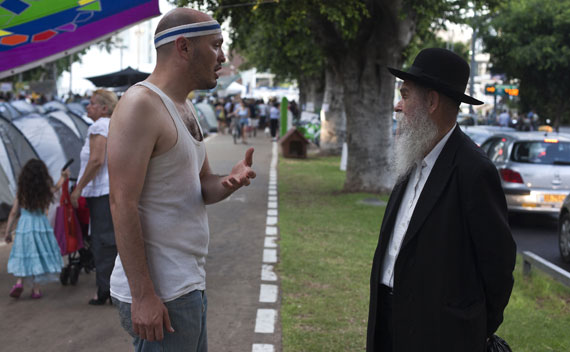Among the Protesters in Israel
More on:

Enjoy the guest post today from my dear friend, Brad Rothschild, who just back from three weeks in Israel.
This past Saturday night, 450,000 Israelis, representing over six percent of the country’s population, took to the streets to demonstrate for social justice in the largest rally in the country’s history. This event, known locally as the “March of the Million,” was the culmination of weeks of protests throughout the country, with tent cities popping up in every major population center. In the days leading up to the demonstration, one question lingered: could the “Israeli Summer” survive into the Fall?
The summer of 2011 will be remembered as the time when Israelis of all ages and political stripes decided that they had had enough. Enough of rising prices, enough of privatization that has benefitted the few at the expense of the many, and enough of the feeling that they were being ignored and abused by their elected officials.
Seven weeks ago, a young woman from Tel Aviv named Daphni Leef failed to find affordable housing. Feeling that she had no other options, she pitched a tent on Tel Aviv’s upscale Rothschild Boulevard and started a Facebook page inviting people to join her protest. Then a funny thing happened: first hundreds, then thousands of people began to join her. Rothschild Boulevard rapidly transformed into a large protest community, lined by tents from end to end. Protest marches were held on Saturday nights, and in early August, 300,000 people demonstrated around the country.
The movement was an amalgamation of long-ignored issues and interest groups. Daphni Leef had opened the floodgates: anyone who had any kind of grievance that had been pushed aside over the years in deference to the country’s defense and security needs had finally come to the fore. The movement is of people who feel that their government is in the thrall of the rich and powerful and that there is no longer a role for the common person – a far cry from the socialist ethos of Israel’s founders. Young people complained about how hard it was to make ends meet even with advanced degrees and often more than one job. Apartment rental rates, which were the catalyst for this movement, have become prohibitively expensive in the center of the country. The prices of basic goods have skyrocketed as well.
But there was something missing. The leaders took great pains to define theirs as a social protest, not a political one. The traditional ideological battles of right and left as it relates to Israel’s continued occupation of the West Bank were downplayed, much to the dismay of many on the left. While this strategy was designed to ensure that the protests attract as wide of a following as possible, it’s impossible to talk about social justice in Israel without including the occupation as a subject for discussion. Israel is in desperate need of a change in national priorities. So much of the state’s annual budget is allocated to the settlement enterprise, which truly benefits a small minority over the vast majority of the population; the status quo cannot be changed without confronting this fact.
In late August, Palestinian terrorists attacked Israeli civilians near Eilat and Israel retaliated by striking targets Gaza. To perpetuate the cycle of violence, Palestinian rejectionists fired rockets and mortars at southern Israel and the Israeli government contemplated its next moves. Against this backdrop, many assumed that the usual Saturday night protests would be postponed because of the "situation." But it was decided that the protests would go on as planned, albeit in silence to commemorate those who lost their lives. Indeed, about 4,000 demonstrators marched in Tel Aviv the following Saturday, but the silence was broken by chants of "In Israel and in the territories, we demand social justice," and "Jews and Arabs refuse to be enemies." Some carried signs that read: "Mr. Prime Minister, you are responsible for welfare, education and health, not only for security."
All of this was a prelude to the “March of the Million.” All of the efforts were being focused on this event as the organizers hoped to hold the largest demonstration in Israeli history. Summer was winding down, the school year had just begun and people were returning to their normal lives. Would this march be the last act in a grand drama that was full of sound and fury but whose end would signal nothing? As the day of the march grew closer, more people spoke about the importance that this movement should outlast the end of the summer march. A man in his sixties expressed jealousy that this generation succeeded in doing something that his couldn’t. Another man said that he was desperate for the movement to succeed because it was the last best hope for his beloved country.
This past Saturday night, 450,000 Israelis dared to imagine an Israel that is just and fair, an Israel that is free from hatred and fear, and an Israel, as one speaker said, that people are willing to die for but in which people want to live. The next day, a smattering of people remained on Rothschild Boulevard; and the police were readying orders to close the tent cities and try to get back to business as usual. The movement for social justice has reached its most critical stage; what it does next will determine whether the Israeli Summer was just a naïve interlude or a harbinger for true social change that could positively impact the lives of Israelis and their neighbors as well.
Brad Rothschild is an independent filmmaker living in New York City. He wrote and produced the feature film, Homeland, and is currently producing a documentary on the efforts to save children within the Buchenwald concentration camp during the Holocaust.
More on:
 Online Store
Online Store